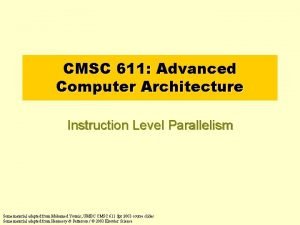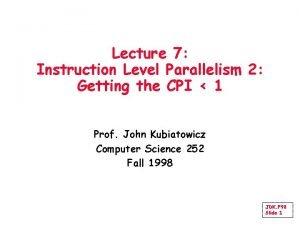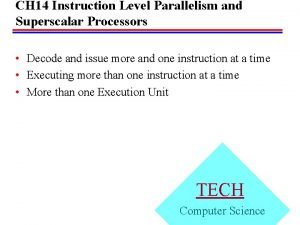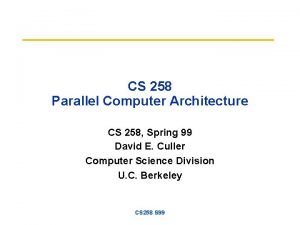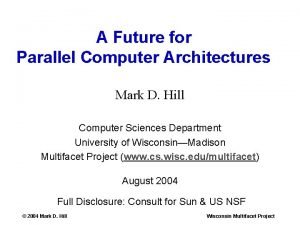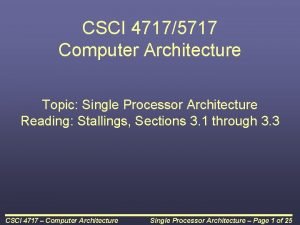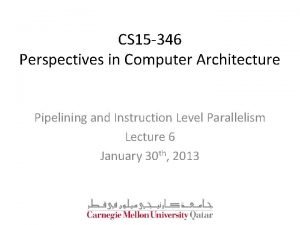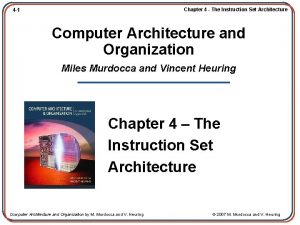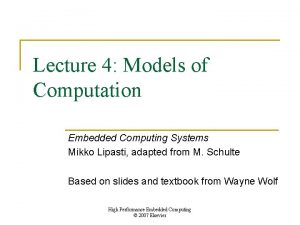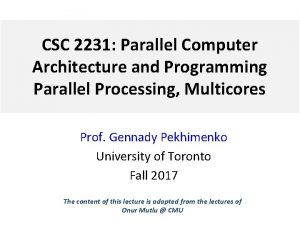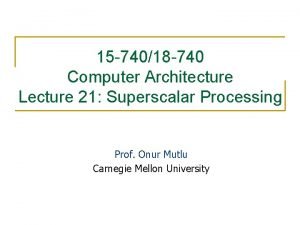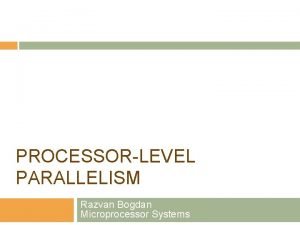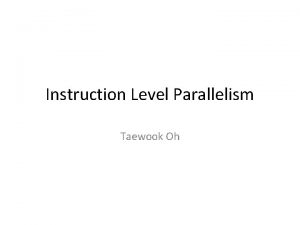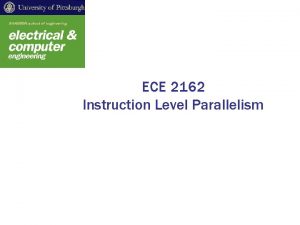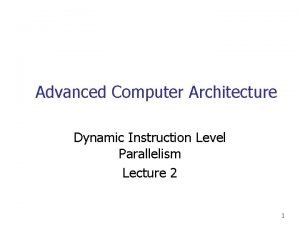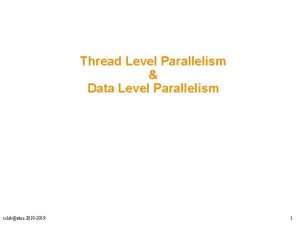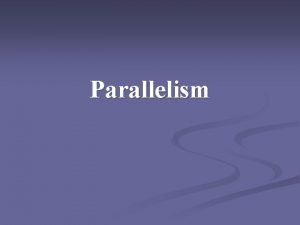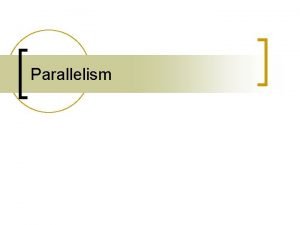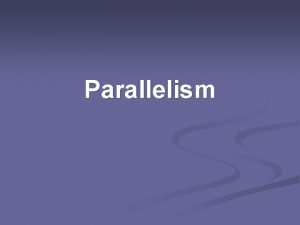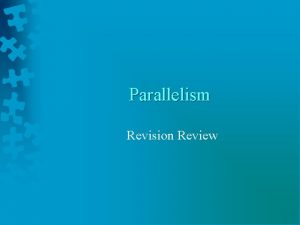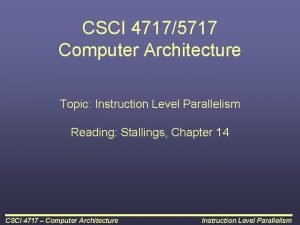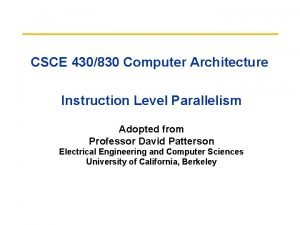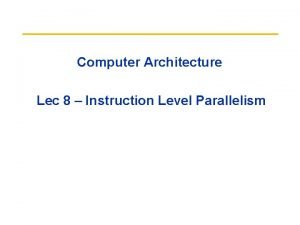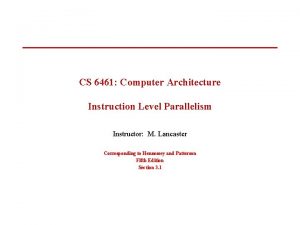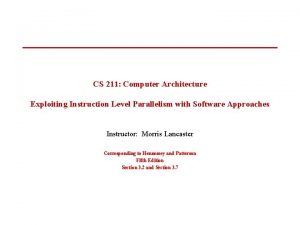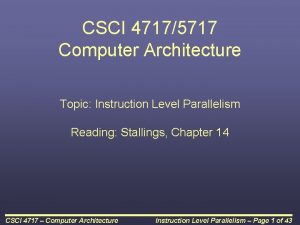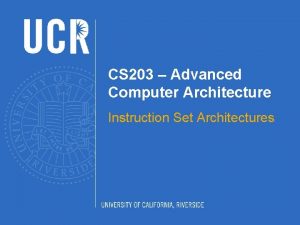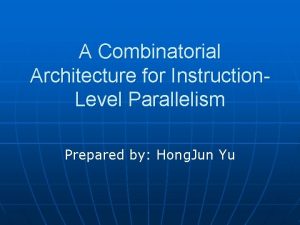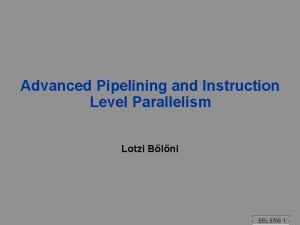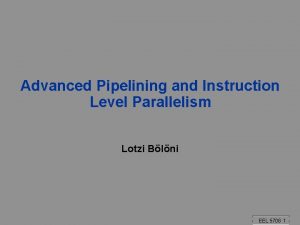CS 203 Advanced Computer Architecture Instruction Level Parallelism











![ILP in Loops Example 1 for (j=1; j<=N; j++) X[j] = X[j] + a; ILP in Loops Example 1 for (j=1; j<=N; j++) X[j] = X[j] + a;](https://slidetodoc.com/presentation_image_h/2adc729a2f7dc37b73408cc1244df7d0/image-12.jpg)
![ILP in Loops (2) Example 3 for (j=1; j<=N; j++) { A[j] = A[j] ILP in Loops (2) Example 3 for (j=1; j<=N; j++) { A[j] = A[j]](https://slidetodoc.com/presentation_image_h/2adc729a2f7dc37b73408cc1244df7d0/image-13.jpg)











![Software Pipelining: Loop: X[i] = X[i] + a; % 0 <= i < N Software Pipelining: Loop: X[i] = X[i] + a; % 0 <= i < N](https://slidetodoc.com/presentation_image_h/2adc729a2f7dc37b73408cc1244df7d0/image-25.jpg)


- Slides: 27

CS 203 – Advanced Computer Architecture Instruction Level Parallelism

Instruction Level Parallelism Instruction-Level Parallelism (ILP): overlap the execution of instructions to improve performance 2 approaches to exploit ILP: Dynamic and Static Dynamic Rely on hardware to help discover and exploit the parallelism dynamically (e. g. , Pentium 4, AMD Opteron, IBM Power) Out-of-Order execution, superscalar architectures Static: Rely on software technology to find parallelism, statically at compile-time (e. g. , Itanium 2)

Instruction-Level Parallelism (ILP) Basic Block (BB) ILP is quite small BB: a straight-line code sequence with no branches in except to the entry and no branches out except at the exit average dynamic branch frequency 15% to 25% => 4 to 7 instructions execute between a pair of branches Plus instructions in BB likely to depend on each other To obtain substantial performance enhancements, we must exploit ILP across multiple basic blocks Implies predicting branches! Simplest form of ILP loop-level parallelism to exploit parallelism among iterations of a loop. E. g. , for (i=1; i<=1000; i=i+1) x[i] = x[i] + y[i];

Loop-Level Parallelism Exploit loop-level parallelism to parallelism by “unrolling loop” either by dynamic via branch prediction and/or dataflow µarchitectures static via loop unrolling by compiler another way is vectors, to be covered later Determining instruction dependence is critical to Loop Level Parallelism If 2 instructions are parallel, they can execute simultaneously in a pipeline of arbitrary depth without causing any stalls (assuming no structural hazards) dependent, they are not parallel and must be executed in order, although they may often be partially overlapped

ILP and Data Dependencies, Hazards HW/SW must preserve program order: Order instructions would execute as if executed sequentially as determined by original source program Dependences are a property of programs Opportunities for dynamic ILP constrained by Dynamic dependence resolution Resources available Ability to predict branches Data dependence, as seen before RAW, WAR, WAW

Structure of Compilers

Compiler Optimizations Goals: (1) correctness, (2) speed. Optimizations High level: at source code level procedure integration Local: within a basic block common sub-expression elimination (cse) constant propagation stack height reduction Global: across basic blocks global cse copy propagation invariant code motion induction variable elimination Machine dependent strength reduction pipeline scheduling load delay slot filling Impact of optimizations Dramatic impact on fp code Most reduction in integer and load/store operations. Some reduction in branches

Effects of Compiler Optimizations

Compilers and ISA How ISA design can help compilers Regularity: keep data types and addressing modes orthogonal whenever reasonable. Provide primitives not solutions: do not attempt to match high-level language constructs in the ISA. Simplify trade-off among alternatives: make it easier to select best code sequence. Allow the binding of compile time known values.

Example: Expression Execution Sum = a + b + c + d; The semantic is Add fs, fa, fb Add fs, fc Add fs, fd 0 3 3 6 6 9 cycles Sum = (((a + b) + c) + d); Parallel (associative) execution Sum = (a + b) + (c + d); Add f 1, fa, fb Add f 2, fc, fd Add fs, f 1, f 2 0 3 1 4 4 7

Compiler Support for ILP Dependency Analysis Loop Unrolling Software Pipelining
![ILP in Loops Example 1 for j1 jN j Xj Xj a ILP in Loops Example 1 for (j=1; j<=N; j++) X[j] = X[j] + a;](https://slidetodoc.com/presentation_image_h/2adc729a2f7dc37b73408cc1244df7d0/image-12.jpg)
ILP in Loops Example 1 for (j=1; j<=N; j++) X[j] = X[j] + a; Dependence within same iteration on X[j]. Loop-carried dependence on j, but j is an induction variable. Example 2 for (j=1; j<=N; j++) { A[j+1] = A[j] + C[j]; /* S 1 */ B[j+1] = B[j] + A[j+1]; /* S 2 */ Loop carried dependence on S 1. Data flow dependence from S 1 to S 2.
![ILP in Loops 2 Example 3 for j1 jN j Aj Aj ILP in Loops (2) Example 3 for (j=1; j<=N; j++) { A[j] = A[j]](https://slidetodoc.com/presentation_image_h/2adc729a2f7dc37b73408cc1244df7d0/image-13.jpg)
ILP in Loops (2) Example 3 for (j=1; j<=N; j++) { A[j] = A[j] + B[j]; /* S 1 */ B[j+1] = C[j] + D[j]; /* S 2 */ Loop carried dependence from S 2 to S 1; but no circular dependencies. Parallel version A[1] = A[1] + B[1]; for (j=1; j<=N-1; j++) { B[j+1] = C[j] + D[j]; A[j+1] = A[j+1] + B[j+1]; } B[N+1] = C[N+1] + D[N+1];

Dependence Analysis Dependency detection algorithms: Determine whether two references to an array element (one write and one read) are the same. assume all arrays indices to be affine X(a. i + b) and X(c. i +d) dependency can exist iff two affine functions have the same value for different indices within the loop bounds: let l <= j, k <= u if (a. j + b = c. k + d) then there is a dependency. But a, b, c, d may not be known at compile time. GCD test sufficient condition for the existence of dependency: if dependency exists then GCD test is true. GCD(c, a) must divide (d-b).

Dependence Analysis (2) GCD Example: X(a. i + b) and X(c. i +d) for(int i=0; i<100; i++) { A[6*i]=B[i]; /*s 1*/ C[i]=A[4*i+1]; /*s 2*/ } GCD test: a=6, b=0, c=4, d=1, GCD(c, a) = 2 & (d-b) = 1 There are no dependencies between the accesses to array A.

Dependence Analysis (3) In the general case Determining whether a dependency exists is NP-complete. Exact tests exist for limited cases. A hierarchy of tests in increasing generality and cost is used. Drawback of dependency analysis: Applies only to references within single loop nests with affine index functions. Where it fails: pointer references opposed to index; indirect indexing (e. g. A[B[I]]) used in sparse matrix computations; when dependency can potentially exist statically but never does in practice (at run time); when optimization depends on knowing which write of a variable a read depends on.

Software Techniques - Example This code, add a scalar to a vector: for (i=1000; i>0; i=i– 1) x[i] = x[i] + s; Assume following latencies for all examples Ignore delayed branch in these examples Instruction producing result FP ALU op Load double Integer op Instruction using result Another FP ALU op Store double Integer op Latency in cycles 4 3 1 1 1 stalls between in cycles 3 2 1 0 0

FP Loop: Where are the Hazards? First translate into MIPS code: To simplify, assume 8 is lowest address for (i=1000; i>0; i=i– 1) x[i] = x[i] + s; Loop: L. D F 0, 0(R 1); ADD. D F 4, F 0, F 2; S. D 0(R 1), F 4; DADDUI R 1, -8; BNEZ R 1, Loop; F 0 <= x[I] add scalar from F 2 store result; x[I] <= F 4 decrement pointer 8 B (DW) branch R 1 != 0

FP Loop Showing Stalls 1 2 3 4 5 6 7 8 9 Loop: stall ADD. D stall S. D DADDUI stall BNEZ Instruction producing result FP ALU op Load double L. D F 0, 0(R 1) ; F 0=vector element F 4, F 0, F 2 ; add scalar in F 2 0(R 1), F 4 ; store result R 1, -8 ; decrement pointer 8 B (DW) ; assumes can’t forward to branch R 1, Loop ; branch R 1!=zero Instruction using result Another FP ALU op Store double FP ALU op stalls between clock cycles 3 overall 9 clock 2 cycles 1

Revised FP Loop Minimizing Stalls 1 Loop: L. D F 0, 0(R 1) 2 DADDUI R 1, -8 3 ADD. D F 4, F 0, F 2 4 stall 5 stall 6 S. D 8(R 1), F 4 ; altered offset when move DSUBUI 7 BNEZ R 1, Loop Swap DADDUI and S. D by changing address of S. D 7 clock cycles, but just 3 for execution (L. D, ADD. D, S. D), 4 for loop overhead. Can we make it faster?

Unroll Loop Four Times 1 cycle stall 1 Loop: L. D 3 ADD. D 6 S. D 7 L. D 9 ADD. D 12 S. D 13 L. D 15 ADD. D 18 S. D 19 L. D 21 ADD. D 24 S. D 25 DADDUI 26 BNEZ F 0, 0(R 1) F 4, F 0, F 2 0(R 1), F 4 F 6, -8(R 1) F 8, F 6, F 2 -8(R 1), F 8 F 10, -16(R 1) F 12, F 10, F 2 -16(R 1), F 12 F 14, -24(R 1) F 16, F 14, F 2 -24(R 1), F 16 R 1, #-32 R 1, LOOP 27 clock cycles, or 6. 75 per iteration Rewrite loop to 2 cycles stall ; drop DSUBUI & BNEZ minimize stalls? ; drop DSUBUI & BNEZ ; alter to 4*8

Unrolled Loop That Minimizes Stalls 1 Loop: L. D 2 L. D 3 L. D 4 L. D 5 ADD. D 6 ADD. D 7 ADD. D 8 ADD. D 9 S. D 10 S. D 11 S. D 12 DSUBUI 13 S. D 14 BNEZ F 0, 0(R 1) F 6, -8(R 1) F 10, -16(R 1) F 14, -24(R 1) F 4, F 0, F 2 F 8, F 6, F 2 F 12, F 10, F 2 F 16, F 14, F 2 0(R 1), F 4 -8(R 1), F 8 -16(R 1), F 12 R 1, #32 8(R 1), F 16 ; 8 -32 = -24 R 1, LOOP 14 clock cycles, or 3. 5 per iteration

Loop Unrolling Decisions Understanding dependencies between instructions and how the instructions can be reordered Determine loop unrolling usefulness by finding that loop iterations were independent (except for maintenance code) Use different registers to avoid unnecessary constraints forced by using same registers for different computations Eliminate the extra test and branch instructions and adjust the loop termination and iteration code Determine that loads and stores in unrolled loop are independent by observing that loads and stores from different iterations are independent: requires analyzing memory addresses and finding that they do not refer to the same address Schedule the code, preserving any dependences needed to yield the same result as the original code

3 Limits to Loop Unrolling 1. Decrease in amount of overhead amortized with each extra unrolling • 2. Growth in code size • 3. Amdahl’s Law For larger loops, concern it increases the instruction cache miss rate Register pressure: potential shortfall in registers created by aggressive unrolling and scheduling • If not be possible to allocate all live values to registers, may lose some or all of its advantage Loop unrolling reduces impact of branches on pipeline; another way is branch prediction
![Software Pipelining Loop Xi Xi a 0 i N Software Pipelining: Loop: X[i] = X[i] + a; % 0 <= i < N](https://slidetodoc.com/presentation_image_h/2adc729a2f7dc37b73408cc1244df7d0/image-25.jpg)
Software Pipelining: Loop: X[i] = X[i] + a; % 0 <= i < N Loop: LD F 0, 0(R 1) ADDD F 4, F 0, F 2 SUBI R 1, #8 SD 8(R 1), F 4 BNEZ R 1, Loop Cycles Assume LD is 2 cycles and ADDD is 3 cycles Total 7 cycles per iteration Interleaves instructions from different iterations without loop unrolling.

Software Pipeline Example LD F 0, 0(R 1) ADDD F 4, F 0, F 2 SUBI R 1, #8 LD F 0, 0(R 1) Loop SD % load X[0] % add X[0] prologue % load X[1] 8(R 1), F 4 % store X[I] ADDD F 4, F 0, F 2 % add X[I-1] LD F 0, 0(R 1) % load X[I-2] SUBI R 1, #8 BNEZ R 1, Loop SD 0(R 1), F 4 % store X[N-2] ADDD F 4, F 0, F 2 % add X[N-1] SD -8(R 1), F 4 % store X[N-1] Symbolic loop unrolling Body: no dependencies epilogue

Software Pipelining (2) Needs startup code before loop and finish code after: Prologue: LD for iterations 1 and 2, ADDD for iteration 1 Epilogue: ADDD for last iteration and SD for last 2 iterations. Software equivalent of Tomasulo. Interleaves instructions from different iterations without loop unrolling. Pros and Cons Makes register allocation and management difficult. Advantage over loop unrolling: less code space used. SP reduces loop idle time, loop unrolling reduces loop overhead. Best use combination of both. Limitations: loop carried dependencies
 Thread level parallelism in computer architecture
Thread level parallelism in computer architecture Ilp computer architecture
Ilp computer architecture Instruction level parallelism
Instruction level parallelism In order issue in order completion example
In order issue in order completion example Parallel processing architecture
Parallel processing architecture Parallelism computer architecture
Parallelism computer architecture Parallelism computer architecture
Parallelism computer architecture Instruction format in computer architecture
Instruction format in computer architecture State diagram in computer architecture
State diagram in computer architecture Scalar pipeline in computer architecture
Scalar pipeline in computer architecture Chapter 4 example
Chapter 4 example Instruction set architecture in computer organization
Instruction set architecture in computer organization Fundamentals of cpu in advanced computer architecture
Fundamentals of cpu in advanced computer architecture 3 bus architecture
3 bus architecture Differentiated instruction vs individualized instruction
Differentiated instruction vs individualized instruction Indirect instruction definition
Indirect instruction definition Bowling tips for advanced bowlers
Bowling tips for advanced bowlers Task level parallelism
Task level parallelism Ece 369
Ece 369 Task level parallelism
Task level parallelism Task level parallelism
Task level parallelism Task level parallelism
Task level parallelism Task level parallelism
Task level parallelism Bit level parallelism
Bit level parallelism Bit level parallelism
Bit level parallelism Organization and architecture difference
Organization and architecture difference Basic computer organisation and design
Basic computer organisation and design Skipcond marie
Skipcond marie

